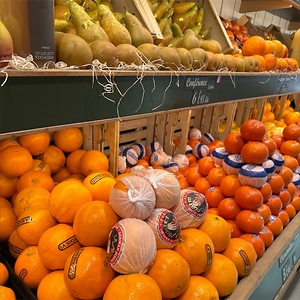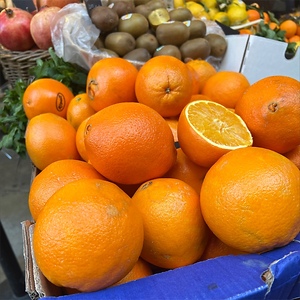


Spanish Navel Oranges
Estimated Inventory, lb : 0
Description/Taste
Spanish Navel oranges are medium to large in size, depending on the specific variety, and have a round to oval shape. The fruit’s overall appearance will vary based on growing conditions and how often it is watered. Oval to oblong navel oranges are the product of being heavily watered, causing the fruits to sag from their weight as they mature on the tree, creating an elongated shape. Spanish Navel oranges also feature a characteristic "navel" or circular hole on the blossom stem end, sometimes seen as a small bump. The fruits have a thin, easy-to-peel rind with a glossy, smooth, and pebbled appearance, a texture created from the prominence of sunken oil glands, creating small bumps on the surface. Some varieties of Spanish Navel oranges may also have rougher, thicker skin. The fruits ripen from green to vibrant shades of red-orange, and the skin is easy to peel. Underneath the surface, Spanish Navel oranges bear a thin layer of white to pale orange, spongy pith that is adhered to the flesh but is relatively easy to remove. The orange flesh is divided into segments by thin membranes and is seedless with a tender, aqueous, soft, and succulent texture. Spanish Navel oranges are aromatic and release sweet, fruity, and floral notes. The flesh is known for its high sugar content mixed with low acidity, creating a mild, sweet, and subtly tangy taste.
Seasons/Availability
Spanish Navel oranges are available from the late fall through late spring, with a peak season from January through May.
Current Facts
Spanish Navel oranges, botanically classified as Citrus sinensis, are a category of sweet navel orange varieties belonging to the Rutaceae family. Oranges have been deeply intertwined in Spanish culture since the 18th and 19th centuries, and the fruits have become an important commercial crop and symbol of happiness. The scent of orange blossoms seasonally permeates the air of citrus-growing regions throughout Spain, and oranges have become so pertinent in daily life that Spanish couples often refer to their significant other as “the other half of their orange.” There are many varieties of navel oranges generally labeled as Spanish Navel oranges in commercial markets, and popular cultivars include Navelina, Newhall, Thomson, Washington Navel, Lane Late, Navelate, Powell Summer Navel, and Ricalate. Navel oranges acquired their moniker from the small protuberance or spot on the end of the fruit. This small opening is created from a genetic mutation within the variety that causes a secondary orange, known as the twin fruit, to grow within the orange. This secondary fruit never fully develops but creates a hole that resembles a human navel or belly button. Spanish Navel oranges are extensively cultivated for domestic sale and export. The fruits are shipped across Europe and are seasonal delicacies favored for fresh and cooked preparations.
Nutritional Value
Spanish Navel oranges are a source of fiber to regulate the digestive tract, potassium to balance fluid levels within the body, magnesium to control nerve functions, phosphorus to repair cell tissues, and vitamin C to strengthen the immune system while reducing inflammation. The oranges also provide calcium to build strong bones and teeth, vitamin A to maintain healthy organ functioning, folate to develop DNA and RNA, vitamin E to protect the cells against free radical damage, and other nutrients, including phosphorus, manganese, zinc, copper, and B vitamins.
Applications
Spanish Navel oranges have a mild, sweet, and subtly tangy taste suited for fresh and cooked preparations. The oranges are popularly consumed out of hand to savor their juicy nature, and slices of the fruits can be served on charcuterie boards, dropped into drinks, or used as an edible garnish on cakes. Spanish Navel oranges can also be segmented and tossed into salads, used as a topping over breakfast dishes such as parfaits and oats, or mixed into fruit medleys. Try chopping Spanish Navel oranges into salsa, blending them into dressings and marinades, or dipping them into chocolate as a snack. In addition to fresh preparations, Spanish Navel oranges can be simmered into jams, jellies, and marmalades, and pure cocoa powder can be mixed into the marmalade as a unique variation. The oranges can also be zested and juiced to flavor cakes, scones, cookies, and other baked goods or cooked into syrups. The rind can be dried and ground into salts and sugars, cooked into sauces for meats, or roasted to create a layer of caramelization and served with cinnamon as a dessert. The rind can also be candied and eaten or used as a topping. Spanish Navel oranges pair well with herbs such as cilantro, parsley, and rosemary, nuts such as pistachios, pecans, almonds, and pine, seafood including shrimp, fish, and scallops, and fruits including strawberries, bananas, coconut, and pomegranate seeds.
Ethnic/Cultural Info
Orange trees are famously planted in the Patio de Los Naranjos, translating from Spanish to mean the “Court of the Oranges.” The courtyard was built within the Mosque at Cordoba in the 10th century and is considered one of the oldest gardens in Europe. The mosque was constructed as a place of political, social, and religious endeavors, the gardens were valued as a restful place and site for washing before prayer. Over 98 orange trees are planted in the courtyard, and the trees are planted in a grid to mirror the layout of the columns inside the mosque. Each tree also has a circular water well around the trunk and is connected to the other trees through straight channels. These water channels were built for more than just watering the trees. They were meant to highlight water’s importance as a life source and as the foundation of agriculture. Water and trees also represented the soft, beautiful aspects of nature mixed into harsh urban settings.
Geography/History
Spanish Navel orange is a general descriptor for navel oranges grown in Spain. There are many varieties of navel oranges cultivated for commercial use throughout the country, and each variety has its own history, with some being native to Spain while others were developed in other regions of the world. Oranges, in general, were introduced to Valencia, Spain, by the Moors in the 10th century. The trees were planted in courtyards, gardens, and mosques for ornamental use. Over time, Spanish growers began cultivating oranges, and in the 18th century, commercial production was spurred through the efforts of a Catholic priest, Father Vicente Monzo Vidal. After his success in orange production, growers across the Valencia region planted orchards of the fruits, and in the 19th century, Spanish oranges were exported to markets in the south of France. Spanish orange exports expanded to Western Europe, and in 1851, the fruits were sent to Britain, marking the start of the Spanish citrus industry. Valencia quickly became one of the central growing regions in Spain. The region is known for its fertile soil and Mediterranean climate, and the orchards are situated along the coast, earning it the nickname of the “Orange Blossom Coast.” Some navel orange varieties were developed in Spain, and other varieties were imported from the United States in the 20th century for commercial cultivation. Today, Spanish Navel oranges are grown in the provinces of Alicante, Valencia, Murcia, Castellon, Sevilla, Cordoba, Almeria, Huelva, and Malaga. When in season, the fruits are sold domestically and exported to European markets as a specialty citrus. The Spanish Navel oranges featured in the photograph above were sourced through fresh markets in London, England.
Recipe Ideas
Recipes that include Spanish Navel Oranges. One
| Food dot com |
|
Spanish Oranges in Wine |









